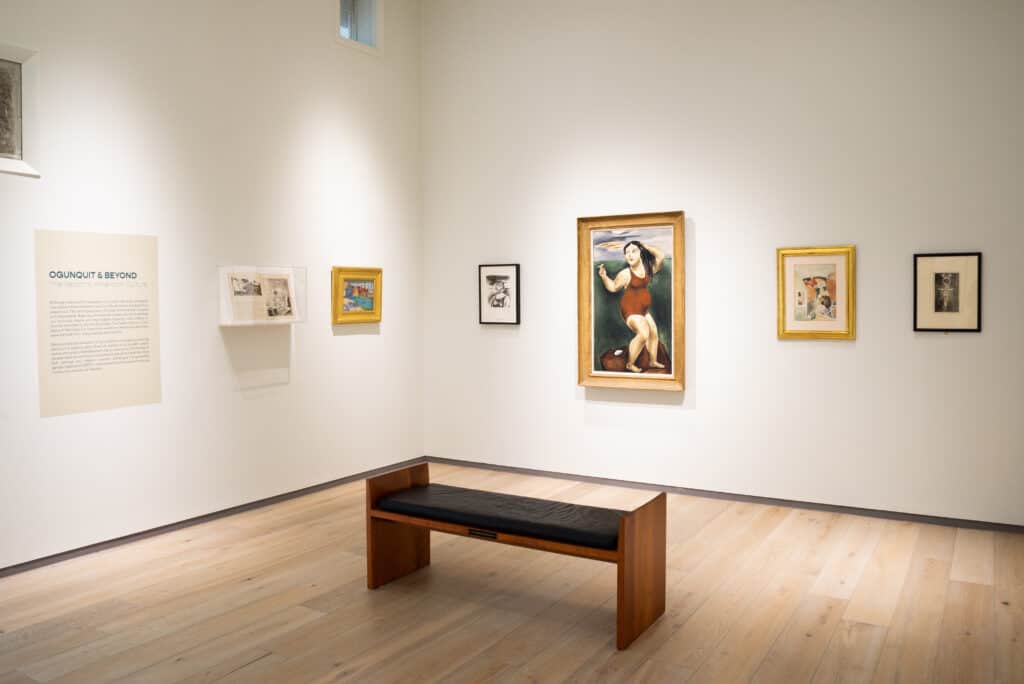George Bellows and Reginald Marsh
By Abby Dunnigan
OMAA is fortunate to have a dynamic intern program, which gives the opportunity for talented undergraduate scholars to learn more about the curatorial field and museum work. We’d like to highlight scholarship by interns that supplements the exhibition Shifting Sands.
Many early twentieth-century American artists turned to contemporary everyday life for inspiration. They were interested in representing “authentic” life and used realism to make viewers feel as though they were witnessing the scene themselves. I will be talking about two artists who used realism in their depictions of modern life and their scenes of the beach in particular to allow their audience to experience the excitement of this increasingly popular social space.
The painter George Bellows moved to New York City in 1904 at the age of 22. He became associated with the group of New York Realists known also as the Ash Can School. As a young man, he was strongly influenced by the cult of masculinity popularized by figures like Teddy Roosevelt. Bellows focused on male musculature and anatomy in his work. The illegal boxing tournaments in New York City that he regularly attended proved to be great opportunities for him to study not only the male body but to present scenes of raw, rugged, and violent masculinity. This subject intrigued Bellows because it was a socially unacceptable space. This same interest led Bellows to the beach. He frequented many beaches around New York City like Coney Island and Splinter Beach. His 1908 painting Beach at Coney Island depicts a crowded scene of figures tightly packed underneath umbrellas and along the water line as they enjoy a hot summer day away from the city. His 1916 print Splinter Beach displays the intersection between the industrial forms of the city and the beach as large boats cross underneath the Brooklyn Bridge and across the path of the swimmers who wade along the shore.
As an environment of raw humanity and bodily exposure, beaches represented the evolution of socially acceptable behavior in the early twentieth century. Bellows’ print, Bathing Beach, in the Shifting Sands exhibit depicts Third Beach in Middletown, Rhode Island. He spent the summers of 1918 and 1919 vacationing there with his family. In Bathing Beach, Bellows shows people in the midst of common beach activities like drying one’s hair, walking across the hot sand, or rolling over to evenly bask in the sun. The partial nudity does not shock the audience as the beach de-scandalized the exposed human body. At the same time, the beach is presented as a space of curiosity. Quick gazes between figures in their bathing suits show excitement even in the most tranquil of beach scenes. The two figures in the foreground share an intimate energy as one of them catches a glance at the other as they turn on their towel. A figure in the middle ground watches as one woman flips her head forward to dry. These short yet electric glances perfectly encapsulate the energy of beaches in the early 1900s.
No urban beach attracted more visitors, artists, and critical spectators than the beaches of Coney Island. Seeking refuge from the congestion and chaos of New York City, working-class people flocked to the equally congested beaches there from the late nineteenth into the twenty-first century. During Coney’s peak popularity in the mid-twentieth century, those long sandy stretches did not serve simply as natural oases but also as havens for American youth pursuing a counterculture that dismissed old-fashioned social norms and embraced sexual liberation.
One of the most important artists to have captured this intoxicating atmosphere of Coney Island was Reginald Marsh. Working from the 1920s and beyond, and influenced by an earlier generation of realist painters, Marsh spent countless days at Coney, observing, scribbling notes
and sketches, and painting the mass culture of leisure and amusement that drew the crowds of millions to the island every year. Two of Marsh’s Coney Island works are in the exhibit and from the collection of the Ogunquit Museum.
One is Belles of Coney Island. Here, Marsh creates two spaces which only connect through the gazes of the figures. The women, scantily dressed in contemporary clothing, reflect the changing social order being cultivated at working-class resorts. Marsh displays the three women on the boardwalk in a different spatial realm from the figures on the beach. The subtle yet direct gazes of the thinly drawn beach figures focus on the three women and thus turn the boardwalk into a stage, the women into the performers, and the beach figures into the audience. The beach became a place of amusement where real people were being observed and observing each other.
Although working at different times in the early 1900s, both Marsh and Bellows focused their art on spaces of loosened social restrictions, working to represent changing modern lifestyles. Marsh went to burlesque shows in New York to study the female body, while Bellows went to the boxing ring to study the male body. Both artists were eventually drawn to urban beaches. There is an evident connection to be made between the popularity of beach-leisure and the scandalous entertainment of burlesque and illegal boxing. All spaces explore human exposure–the physical and emotional exposure of the beach, of burlesque halls, and of the boxing ring. Marsh and Bellows used realism to depict the emerging mass-culture of leisure and entertainment with a prominent subject for them both centering around the beach.



